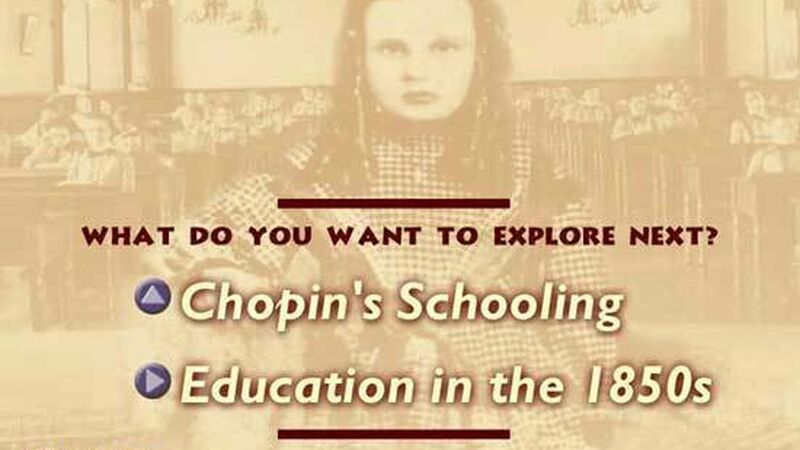Schooling & Education: Chopin's Schooling

Chopin's Schooling
Transcript
NARRATOR: Kate attended Sacred Heart as both a boarding and a day student during the 1850s and 60s. In addition to French and music, the nuns placed heavy emphasis on teaching their students science, which was especially unusual. And, of course they taught religion. Scholars say in some respects Chopin's education was unusual, in other ways it was not.
SOUNDBITE: E. F. Genovese/Emory University Unusual in the sense that it was after all a Catholic school and a large part of the South was Protestant and Evangelical Protestant. Unusual in the sense that it appears to have been a fine education which in her day was not available to the majority of southern women. But, not unusual in the sense that elite southern women did receive a good education, arguably better than the northern women or most northern women in their same general class and background.
NARRATOR: At Sacred Heart, young Kate O'Flaherty benefited more perhaps from the school's commitment to writing.
SOUNDBITE: Emily Toth/Louisiana State University What they stressed was writing, writing forcefully and clearly, and I couldn't have designed a better curriculum for Kate myself, you know, it was exactly what she needed and what she wanted.
SOUNDBITE: David Chopin/Kate's Grandson She had her own thing that was sort of a spontaneous love of literature and writing and ah, I don't know if she really had too much patience with the formal education of her time. I know that she was taught by the madams at Sacred Heart in her earlier days, and I think that she had to come into her own for her talents, and I think they didn't have to put it into her. I think, they were there and they came out spontaneously.
NARRATOR: Kate's family was also diligent in preparing her for what would become a career in writing. Her great grandmother, Madame Charleville may have had the biggest influence on her education.
SOUNDBITE: Emily Toth She taught her what's most important actually is story telling, story telling is a way of understanding the world, gossip as being important at telling us things about people's lives. She taught her not to believe in censorship or things, or restricting herself to things that are not appropriate or nice. She raised a child, Kate, who was a questioner, who was curious, who had a satirical side, a cynical side, who thought it was more important to be clever than to be cute, and that was unusual, too.
NARRATOR: Since students at Sacred Heart were expected to become homemakers, they were also shown how to sew, embroider and garden. Kate graduated from Sacred Heart in 1868. She was one of four students in her class to receive the school's highest honor in academics.
Schooling & Education: Education in the 1850's

Education in the 1850's
Transcript
NARRATOR: During Kate Chopin's adolescent years, about seventy-five percent of upper class white girls had the opportunity to get a formal education. But, that number dropped to only about 30-percent in the South. Scholars say not only did society put restrictions on education for females�families did as well.
SOUNDBITES: Donald DeVore/Amistad Research Center
Most parents, mothers and fathers, also saw their females in a limited way for professional choices. And many times people just didn't think it was the correct thing to do. Too much education may have made a female unfit for marrying so there were restrictions placed on educational aspirations and opportunities for females by the family, as well as by the larger society.
E.F. Genovese/Emory University
When they were growing up and they were in school, in the 1850s and 1860s there weren't very many opportunities for women to become independent professional intellectuals. A schoolteacher was not normally something that a woman of their class, background would do, especially in the southern states.
NARRATOR: Families who were committed to making sure their daughters were well educated had options. They could have done what Kate Chopin's mother did�send the girls to academies. The private schools were growing in popularity.
SOUNDBITE: Donald DeVore/Amistad Research Center
Generally speaking, and you had to kind of look at each academy, a female academy probably provided a better environment for females than a mixed setting.
NARRATOR: Even when white women were fairly well educated, they were limited in career choices. The conventional thinking throughout the 19th century was that the woman's place was in the home, having children�and caring for her family. For more affluent white households, that included supervising the servants. So, schools focused heavily on teaching girls about cooking, sewing and keeping track of household expenses. Some African Americans may have had an easier time than women getting an education.
SOUNDBITE: Donald DeVore/Amistad Research Center, Tulane
It was illegal for anyone to formally educate slaves. Nonetheless, since slaves participated in many ways in the southern economy, often times masters participated in educational activities just to make slaves more efficient in a variety of tasks.
NARRATOR: During the 1860s its estimated that about five to six percent of African Americans were literate, knowing the basics of reading, writing and arithmetic. In general, educational opportunities were much better for boys. Males were encouraged to go to college, since the U.S. was beginning to move more toward industrialization. Back to Kate Chopin, she established many relationships at her private girls' school, Sacred Heart.

